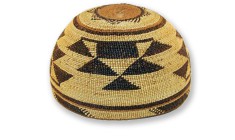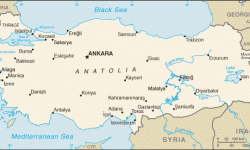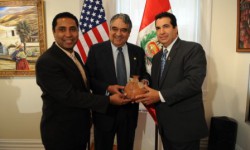Weary Herakles

A Roman sculpture: the bottom half was archaeologically excavated at the Turkish site of Perge and the top half was looted and eventually placed on display at the Museum of Fine Arts, Boston, USA.
Since the early 1980s, debate and dispute have surrounded two halves of a Roman sculpture dating from the Late Antonine period (AD 170-192), “of a type known as the Weary Herakles” (in Rose and Acar 1995: 49). Such statues were not uncommon, with many made in this period based on an original 4th Century BC sculpture by the sculptor Lyssipos of Sicyon (Kornblut 1998).
In 1980, excavations at Perge in southern Turkey uncovered the lower half of a Weary Herakles statue, amid rumours that looting at the site had included a large item, which many thought may well have been the top half of the same statue (McElroy 2005: 551). In fact at the time of the excavation of the bottom half of the statue, Jale Inan, director of excavations had heard “rumors that something important had been stolen from the site”(Rose and Acar 1995: 48, sic.)
Just one year later in 1981, what would later prove to be the top half of the statue was acquired by the Museum of Fine Arts (MFA), Boston, in fifty-percent partnership with collectors Shelby White and Leon Levy, and it was first exhibited the following year as part of a temporary exhibition at the Metropolitan Museum of Art in New York (MFA 2011). The agreement made between the MFA and the New York-based husband and wife collectors White and Levy was that the MFA would receive full ownership upon the death of Leon Levy (Edgers 2011a).
Meanwhile, the bottom half of the statue was displayed in the Antalya Museum (Anatolia News Agency 2009), shown in recent years in association with a photograph of the upper half of the statue (Akca et al. 2006; Brodie et al. 2000: 32). Furthermore, a “collage” of newspaper cuttings was displayed alongside the Antalya half, describing the ongoing dispute with the MFA (Edgers 2011a).
Although seemingly clear from photographs of both halves of the Weary Herakles, and with the corroborative, although anecdotal, reports of a theft from the Perge site not long before the top half emerged in the USA, efforts to prove the connection between the two halves were at first unproductive. Furthermore, the point that the statue type was known to have been made in reasonable abundance, suggesting that there could be numerous fragments of Weary Herakles statues in existence, had been used by MFA staff such as department head Cornelius C. Vermeule III, to cast doubt on the likelihood that the two halves were from the same statue (Kornblut 1998). Three attempts were made to show that the two pieces were actually parts of the same statue, through the use of various plaster casts (Rose and Acar 1995: 48). Eventually, in 1992, a cast of the lower half was transported to Boston from Antalya and this satisfied observers, including Turkish officials and scholars such as the Metropolitan Museum’s former director Thomas Hoving, that the two halves were in fact of the same statue (Kornblut 1998). However, even this was not initially enough to convince the MFA that their half should be repatriated to Turkey. The MFA suggested that the upper half may have broken, either naturally or accidentally, and been then separated (and exported) before the relevant law had come into force in Turkey that would have prohibited such an action (Akca et al. 2006). The MFA’s director of public relations at the time, Robert P Mitchell, even went on record in the Los Angeles Times in 1994, saying:
‘The Museum does not acknowledge Turkey’s claim to ownership. There has never been any evidence that the statue was stolen, and allegations to that effect were entirely unsupported…. Indeed, the break between the top and bottom halves of the statue appears to be an ancient one, such that the top half could have been removed long ago from the territory that is now known as Turkey. In the unfortunate event that the current settlement discussions are not successful, a lawsuit would be necessary. Such a case would raise significant questions.’
(cited in Rose and Acar 1995: 49)
In 2003, Leon Levy passed away (Miller 2007), and by 2004 the MFA had assumed full ownership of the top half of the Weary Herakles, at which point the museum reopened discussions with the Turkish government (MFA 2011); apparently such negotiations were made easier by not having to involve a donor in the discussions (Edgers 2011a).
Finally in 2011 an agreement was reached to return the MFA’s half of the statue to Turkey (BBC 2011; MFA 2011). Some observers have expressed surprise at how long the process has taken (Edgers 2011a), and prior to the return of the statue, a lack of objection by the MFA to relevant stories run in Boston’s Globe newspaper was perceived by others almost as an admission of guilt with regard to the case (Robinson 1998).
After the return, the MFA notably appointed the first ‘Curator of Provenance’ in a US museum, albeit focusing specifically on objects connected to confiscations by the Nazis during the Second World War (Edgers 2011b). In addition, the return of the Weary Herakles has been attributed with building confidence within the Turkish government to pursue further repatriation claims, connected with plans for a new National Museum in Ankara which, Turkey hopes, will rival such institutions as the Louvre and the British Museum (The Economist Newspaper 2012).
References
Agency, Anatolia News (2009), ‘Turkish cultural heritage in the hands of foreigners’, Hurriyet Daily News (updated 05/01/2009) http://www.hurriyet.com.tr/english/lifestyle/10697408_p.asp, accessed 11/06/2012.
Akca, Devrim, et al. (2006), ‘3D Modeling of the Weary Herakles Statue’, 5th International Symposium Turkish-German Geodetic Days (Berlin), http://www2.isikun.edu.tr/personel/akca/devrim/2006DE_Akca_et_al_Berlin06.pdf, accessed 11/06/2012.
BBC (2011), ‘Weary Herakles bust to be returned by US to Turkey’, http://www.bbc.co.uk/news/entertainment-arts-14246476?print=true, accessed 12/08/2011.
Brodie, Neil, Doole, Jenny, and Watson, Peter (2000), ‘Stealing History: The Illicit Trade in Cultural Material’, (Cambridge: The McDonald Institute for Archaeological Research, University of Cambridge).
Edgers, Geoff (2011a), ‘Making ‘Herakles’ whole after all these years’, (updated 17/07/2011), http://articles.boston.com/2011-07-17/ae/29784781_1_mfa-museums-turkey, accessed 11/06/2012.
— (2011b), ‘A detective’s work at the MFA’, Globe, 11/12/2011.
Kornblut, Anne E. (1998), ‘Getting to the bottom of split statue’, Boston Globe, 27/12/1998, p. A30.
McElroy, Jason (2005), ‘The War Against the Illegal Antiquities Trade: Rules of Engagement for Source Nations’, Hastings Communications and Entertainment Law Journal, 27, 547-66.
MFA (2011), ‘Museum of Fine Arts, Boston, and Turkish Republic Reach Agreement for Transfer of Top Half of Weary Herakles to Turkey’, Museum of Fine Arts, Boston, 23 September
Miller, Michele A (2007), ‘Introduction to Feature Section: Looting and the Antiquities Market’, Athena Review, 4 (3).
Robinson, Walter V (1998), ‘Museum defends artifacts collection; Due diligence cited in MFA’, Boston Globe, 29 December, B01.
Rose, Mark and Acar, Ozgen (1995), ‘Turkey’s War on the Illicit Antiquities Trade’, Archaeology, 54 (2), 45-56.
The Economist Newspaper (2012), ‘Of marbles and men: Turkey gets tough with foreign museums and launches a new culture war’, The Economist Newspaper (updated 19/05/2012) http://www.economist.com/node/21555531/print, accessed 25/05/2012.




